German Unity Day: A Comprehensive Guide to its History, Importance, and Celebrations
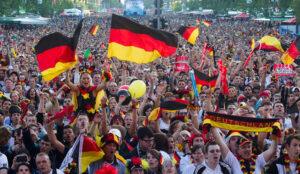
German Unity Day, known as “Tag der Deutschen Einheit,” is celebrated every year on October 3rd, marking the anniversary of Germany’s reunification in 1990. This national holiday symbolizes not only the end of Germany’s division into East and West but also the culmination of the Cold War era in Europe. It is a day filled with political significance, cultural celebrations, and reflections on the turbulent path that led to reunification.
Germany’s unity had been split for nearly 45 years following the conclusion of World War II, and the events that led to the reunification were deeply intertwined with the broader geopolitical shifts of the time. German Unity Day not only commemorates the nation’s physical reunification but also the return of sovereignty to the German people, alongside the fall of the Iron Curtain and the collapse of communist regimes across Europe.
This article dives deeply into the historical context, the significance of the holiday, the celebrations held across Germany, and its modern-day implications.
-
The Historical Background of German Unity Day
1.1 Germany After World War II: The Division
At the end of World War II in 1945, Germany was left in ruins, both physically and politically. The victorious Allied powers—primarily the United States, the Soviet Union, the United Kingdom, and France—divided the nation into four occupation zones. This arrangement was initially intended to be a temporary solution, with the ultimate goal of rebuilding a unified German state.
However, ideological differences between the Western Allies and the Soviet Union soon escalated, leading to the formation of two distinct German states in 1949. In the West, the Federal Republic of Germany (FRG) was founded, often referred to as West Germany, aligning with the capitalist and democratic Western bloc. In the East, the German Democratic Republic (GDR) was established, a socialist state under Soviet influence.
The division of Germany reflected the larger global conflict of the Cold War, pitting capitalist Western nations against the communist Eastern bloc. Over time, the political, economic, and social structures of the two Germanies diverged significantly.
1.2 The Construction of the Berlin Wall

One of the most iconic and tragic symbols of Germany’s division was the Berlin Wall. Constructed in 1961 by the East German government, with Soviet backing, the Wall physically and ideologically separated East and West Berlin. Families were split, lives disrupted, and the movement of people between the two Germanies was restricted to prevent the mass exodus of East Germans fleeing to the more prosperous West.
For nearly three decades, the Berlin Wall became a stark representation of the divide between not only East and West Germany but also the broader ideological conflict of the Cold War.
1.3 The Path to Reunification
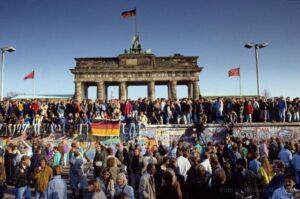
The events leading to German reunification began in the late 1980s, driven by a combination of internal unrest in the GDR and the broader collapse of communist regimes across Eastern Europe. In 1985, Mikhail Gorbachev became the leader of the Soviet Union, introducing policies of glasnost (openness) and perestroika (restructuring), which allowed for greater political freedom and economic reforms. These changes fueled demands for reform in East Germany, as well as other communist nations.
In 1989, peaceful protests known as the Monday Demonstrations (Montagsdemonstrationen) began in Leipzig and soon spread across the GDR. East Germans demanded greater freedoms, democratic reforms, and, ultimately, the ability to leave the country. On November 9, 1989, under immense pressure, the East German government opened the Berlin Wall, allowing free movement between East and West Berlin for the first time in decades. This historic event paved the way for German reunification.
The reunification process formally began with negotiations between the two German states and the four Allied powers. On October 3, 1990, the GDR officially joined the Federal Republic of Germany, marking the formal reunification of the country.
Damien Priest vs. Finn Balor: anything goes WWE Bad Blood 2024 results
-
The Significance of German Unity Day
2.1 A Symbol of Peaceful Revolution
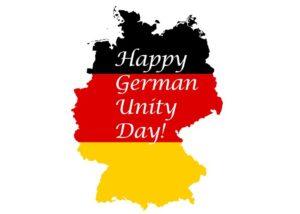
German Unity Day stands as a symbol of the peaceful revolution that took place in the GDR, leading to the collapse of the communist regime and the eventual reunification of the country. Unlike many other uprisings in history, the fall of the Berlin Wall and the reunification were largely non-violent, demonstrating the power of peaceful protest and diplomacy.
The holiday serves as a reminder of the potential for change through unity, resilience, and non-violence, making it a point of pride for Germans.
2.2 The End of the Cold War Era in Europe
German reunification marked one of the key turning points in the end of the Cold War. The collapse of the Berlin Wall was a prelude to the fall of other communist regimes in Eastern Europe, as nations like Poland, Hungary, and Czechoslovakia followed similar paths toward democratic reform and independence from Soviet influence.
Thus, German Unity Day is not only a celebration of Germany’s reunification but also a commemoration of the broader geopolitical changes that reshaped Europe during the late 20th century.
2.3 A Reflection on Democracy and Freedom
For many Germans, October 3rd is a day to reflect on the values of democracy, freedom, and human rights. The reunification of Germany was made possible not only by diplomatic negotiations but also by the people’s demand for political freedom. In the years since reunification, Germany has become one of the leading democratic nations in Europe, playing a key role in promoting these values on the global stage.
|WWE Bad Blood 2024| Roman & Cody Vs The Bloodline
-
How German Unity Day is Celebrated
3.1 Official Ceremonies and Political Speeches
Each year, a major German city hosts the official celebrations for German Unity Day, rotating the honor among the 16 federal states. The celebrations usually include an official ceremony attended by political leaders, including the President of Germany, the Chancellor, and other government officials. These ceremonies are marked by speeches that reflect on the significance of the day and the progress that Germany has made since reunification.
In addition to political speeches, the day often features performances by choirs and orchestras, paying tribute to the nation’s cultural heritage.
3.2 Cultural Events and Festivals
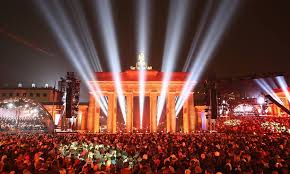
German Unity Day is not only a day of political reflection but also a time for cultural celebration. Across the country, cities and towns host festivals, concerts, and public events to mark the holiday. These events often include traditional German music, dance performances, and food stalls offering regional specialties.
In Berlin, the capital city, the celebrations are particularly vibrant. Brandenburg Gate, a symbol of Germany’s division and reunification, becomes the focal point of large-scale public festivities, including fireworks, open-air concerts, and street fairs.
3.3 Open Houses and Tours
As part of the Unity Day celebrations, many government institutions, including the German Bundestag (parliament), open their doors to the public. This tradition, known as Tag der offenen Tür (Day of the Open Door), allows citizens to tour government buildings, learn more about their functions, and engage with politicians and government representatives.
Many museums, cultural institutions, and historical landmarks also offer free admission on German Unity Day, encouraging people to explore Germany’s rich history and heritage.
3.4 Symbolic Acts of Unity
In some cities, citizens and local officials participate in symbolic acts of unity, such as the laying of wreaths at memorials dedicated to those who lost their lives attempting to flee the GDR. These gestures serve as reminders of the human cost of Germany’s division and the importance of continuing to protect the freedoms won through reunification.
3.5 Unity Runs and Charity Events
Over the years, Unity Runs (Einheitslauf) and other charity events have become popular ways to celebrate German Unity Day. These events promote health and fitness while also raising money for various social causes, further emphasizing the theme of unity and togetherness.
-
The Impact of Reunification on German Society
4.1 The Economic Challenges of Reunification
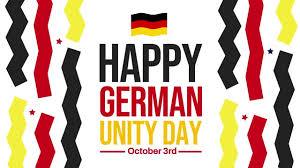
While German reunification was a moment of great joy and celebration, it also posed significant economic challenges, particularly in integrating the economies of the former East and West. West Germany’s economy was far more developed than that of the East, where industries were outdated, and infrastructure had deteriorated under decades of communist rule.
The reunification required a massive transfer of wealth from West to East, with the federal government investing billions of euros in infrastructure projects, social services, and job creation programs. Despite these efforts, economic disparities between the former East and West Germany persisted for years.
However, in the decades since reunification, significant progress has been made. Many regions in the former East have seen a revival of industries, an increase in living standards, and improvements in infrastructure, though some disparities remain.
IND VS BAN 2024 Test Series Full Highlights
4.2 Social and Cultural Integration
Beyond the economic challenges, reunifying two societies that had developed under different political systems for over 40 years was a complex process. People in the former East Germany (known as Ossis) and those in the West (known as Wessis) often had different perspectives on politics, work, and daily life, shaped by their unique historical experiences.
For many East Germans, reunification was a mixed experience. While they gained political freedoms and access to a higher standard of living, they also faced the loss of jobs and industries that had been sustained by the GDR’s socialist economy. The social integration of the two regions took time, with some former East Germans feeling like second-class citizens in the newly united country.
Cultural differences also manifested in language, media, and societal norms, and the process of coming together as one unified society continues to this day. However, younger generations, who grew up in a reunified Germany, have largely embraced a shared national identity, with many seeing the distinctions between East and West as a thing of the past.
iOS 18 just launched and all my iPhone’s supports it!! Does your iPhone support iOS 18- check here
-
German Unity Day and International Relations
5.1 Germany’s Role in Europe
Since reunification, Germany has emerged as one of the most influential nations in Europe. Its strong economy, commitment to democratic values, and leadership within the European Union (EU) have positioned Germany as a key player in European and global affairs.
German Unity Day not only celebrates national reunification but also serves as a reminder of Germany’s responsibility to promote peace and stability in Europe. As the EU’s largest economy, Germany plays a crucial role in shaping the policies and future direction of the European Union.
5.2 The Special Relationship with the United States
The reunification of Germany was made possible in large part by the support of the United States. During the Cold War, the U.S. had been a key ally of West Germany, providing military and economic support. After the fall of the Berlin Wall, the U.S. played a pivotal role in the reunification process, supporting Germany’s full sovereignty and its integration into NATO.
To this day, German Unity Day is an opportunity to reflect on the strong transatlantic relationship between Germany and the U.S., which continues to be a cornerstone of German foreign policy.
5.3 Relations with Russia
While reunification was a triumph for Germany and the Western allies, it also marked the end of the Soviet Union’s influence in Eastern Europe. Relations between Germany and Russia have been complex in the years since reunification, with periods of cooperation and tension.
On German Unity Day, it’s not uncommon for German politicians to reflect on the delicate balance of maintaining good relations with Russia while also standing firm on democratic principles, especially in light of more recent geopolitical tensions.
iOS 18 Glitch Triggers Constant Crashes in Messages App- Quick Fix Guide
-
The Legacy of German Unity Day
6.1 Reunification as a Global Model
Germany’s peaceful reunification is often viewed as a model for other divided nations, demonstrating that it is possible to overcome deep-seated political, economic, and ideological differences through diplomacy and peaceful protest. This legacy has inspired movements for democracy and unification around the world.
6.2 Challenges and Progress
While the reunification of Germany is often celebrated as a success story, the journey has not been without challenges. Economic disparities between the former East and West, social integration issues, and the rise of nationalist sentiments in recent years have tested the unity that was so hard-won in 1990.
However, despite these challenges, Germany has made significant progress in building a unified, democratic, and prosperous society. German Unity Day continues to serve as a reminder of the importance of maintaining that unity and addressing the lingering issues that stem from the country’s division.
6.3 The Future of Unity in Germany
As Germany looks to the future, the meaning of unity continues to evolve. While the physical and political reunification of Germany was achieved in 1990, the social and cultural unification is an ongoing process. German Unity Day remains a day of reflection, celebration, and renewed commitment to building a society that is inclusive, equitable, and united.
Gunther vs Sami Zayn- A Decisive Battle Who Will Dominate the Heavyweight Division?
Conclusion
German Unity Day is a powerful symbol of the resilience of the German people, their ability to overcome division, and their commitment to democracy and freedom. It stands as a reminder of the challenges Germany faced during the Cold War and the triumphs of reunification, offering lessons in the value of peaceful protest, international cooperation, and the enduring importance of unity in the face of division.
As Germany continues to evolve, so too does the significance of this important holiday. Whether through official ceremonies, cultural celebrations, or personal reflections, German Unity Day is an opportunity to honor the past, celebrate the present, and look forward to a future of continued unity and progress.
Please Follow Us On Facebook & Instagram for more detailed posts.

[…] German Unity Day: Remembering the Fall of the Wall and the Rise of Unity […]
[…] German Unity Day: Remembering the Fall of the Wall and the Rise of Unity […]